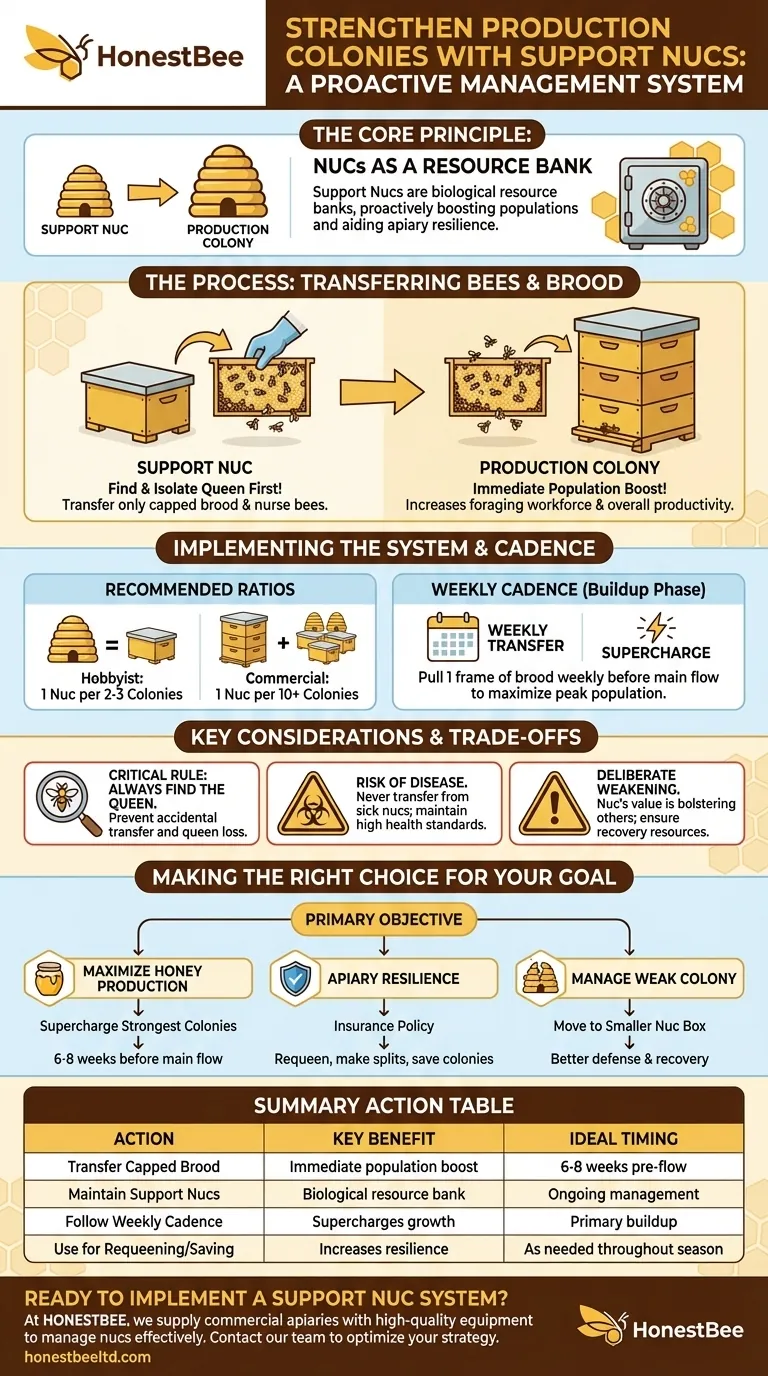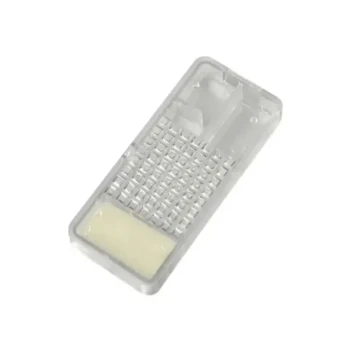To strengthen a production colony, you can systematically transfer resources from a smaller nucleus colony, or "nuc." This involves moving frames of capped brood along with their adhering nurse bees from the support nuc directly into your main production hive. This process provides an immediate and significant boost to the production colony's population, increasing its foraging workforce and overall productivity.
The core strategy is not just a one-time fix, but a management system. By maintaining dedicated "support nucs," you create a biological resource bank for your entire apiary, allowing you to proactively boost populations, replace queens, and save failing colonies.

The Core Principle: Nucs as a Resource Bank
Using nucs to strengthen larger hives is a fundamental technique for proactive apiary management. It shifts you from a reactive beekeeper who only fixes problems to a manager who anticipates needs and optimizes for success.
What is a Support Nuc?
A support nuc is a nucleus colony that is not managed for honey production. Its sole purpose is to serve as a source of bees and brood for your primary production colonies.
These nucs are deliberately kept strong enough to grow but are regularly "bled" of resources to fuel the growth of other hives.
The Transfer Process: Bees and Brood
The most valuable resource you can transfer is a frame of capped brood that is close to emerging.
This single frame provides a triple benefit: it brings the imminent population of new worker bees, the existing nurse bees that are covering the frame, and a boost to the pheromones that signal a healthy, growing colony.
The Critical Rule: Always Find the Queen First
Before moving any frame from the nuc, you must locate the nuc's queen. The goal is to transfer only brood and worker bees.
Accidentally transferring the nuc's queen into the production colony will almost certainly result in one of the queens being killed, defeating the purpose and potentially setting back both hives.
Implementing the Support Nuc System
A systematic approach ensures you strengthen your main hives without fatally weakening your support nucs. The key is balance and consistency.
Recommended Ratios for Your Apiary
For hobbyist and sideliner beekeepers, a good rule of thumb is to maintain one support nuc for every two to three production colonies. This provides enough resources for significant boosts without requiring too much extra equipment.
Commercial beekeepers, who manage risk across a much larger scale, may operate on a ratio closer to one nuc for every ten or more production hives.
The Weekly Cadence
During the primary buildup phase before the main nectar flow, you can pull one frame of brood from a support nuc weekly.
This consistent transfer acts like a supercharger for the production colony, ensuring it reaches its maximum population precisely when the most nectar is available.
Understanding the Trade-offs
This strategy is powerful, but it's essential to understand the costs and potential risks involved. You are making a deliberate sacrifice in one area to gain an advantage in another.
Deliberately Weakening the Support Nuc
Every time you pull a frame of brood, you are weakening the support nuc. This is the intended trade-off. The nuc's value is not in its own production, but in its ability to bolster others.
You must ensure the nuc has enough resources, including a healthy queen and sufficient food stores, to recover from these weekly draws.
Risk of Disease Transmission
This process is a direct vector for pests and pathogens. If your support nuc has a high varroa mite load or a brood disease like chalkbrood, you will transfer it directly into your strongest colony.
Never take resources from a visibly sick or struggling nuc. Your support nucs must be managed to the same or higher standard of health as your production hives.
Saving a Colony vs. Boosting It
If a production colony becomes critically weak, boosting it with a single frame may not be enough. The large, empty space of a full-size hive can be difficult for a small cluster to defend against pests like wax moths or small hive beetles.
In these cases, the better strategy is often to move the weak colony out of its large hive and into a smaller nuc box. This smaller, more defensible space allows the colony to recover more effectively.
Making the Right Choice for Your Goal
How you use nucs depends entirely on your primary objective for the season. Be clear about your goal, and deploy your resources accordingly.
- If your primary focus is maximizing honey production: Use support nucs to supercharge your strongest colonies in the 6-8 weeks leading up to the main nectar flow.
- If your primary focus is apiary resilience: Maintain support nucs as an insurance policy to requeen hives, make emergency splits, and save colonies that might otherwise perish.
- If your primary focus is managing a very weak colony: Move the entire failing colony into a smaller nuc box to give it a better chance of defense, recovery, and growth.
By viewing your nucleus colonies as a dynamic resource, you transform your apiary into a more resilient and productive operation.
Summary Table:
| Action | Key Benefit | Ideal Timing |
|---|---|---|
| Transfer Frames of Capped Brood | Immediate population boost for production hives | 6-8 weeks before main nectar flow |
| Maintain Dedicated Support Nucs | Acts as a biological resource bank for the apiary | Ongoing, as part of a management system |
| Follow a Weekly Cadence | Supercharges colony growth for peak nectar flow | Primary buildup phase |
| Use for Requeening & Saving Colonies | Increases overall apiary resilience | As needed throughout the season |
Ready to implement a support nuc system and build a more resilient, productive apiary?
At HONESTBEE, we supply commercial apiaries and beekeeping equipment distributors with the high-quality, durable supplies needed to manage support nucs and production colonies effectively. From nuc boxes and frames to essential hive tools, our wholesale-focused operations ensure you have the right equipment for success.
Contact our team today to discuss how our beekeeping supplies can help you optimize your apiary management strategy.
Visual Guide

Related Products
- 5 Frame Wooden Nuc Box for Beekeeping
- Twin Queen Styrofoam Honey Bee Nucs Mating and Breeding Box
- Automatic Heat Preservation 6 Frame Pro Nuc Box for Honey Bee Queen Mating
- Plastic Transporting Bee Packages and Nuc Boxes for Beekeeping
- Styrofoam Mini Mating Nuc Box with Frames Feeder Styrofoam Bee Hives 3 Frame Nuc Box
People Also Ask
- What is the most common type of standard nuc? The 5-Frame Nuc Explained
- What are the benefits of moving nuclei around the apiary? Master Strategic Hive Management
- What are the benefits of starting a new bee colony in a nuc box? Boost Colony Success with Efficient Beekeeping
- What are the benefits of using nucs for beginning beekeepers? Ensure a Successful First Hive with a Head Start
- How many frames does a typical wooden nuc box hold? A Guide to Choosing the Right Size



















